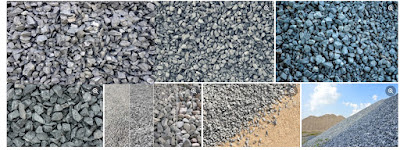Stone Selection
In examining & contemplating, the usage and utilization of stones for different engineering & designing works, characteristics & quality of stone is governed by the reason and purpose in view, its decorative and ornamental value, cost of stone, & durability. Different Types of stones for various purposes and situations are briefly discussed below.
1. For face work, in general marble, granite and close-grained sand stone
are utilized & used in the form of thin slabs (veneers) where the structure
& construction subjected to adverse weather effects.
2. For pillars, columns statues , balustrade, pedestals, and door and window
sill and granite marble , paving stone, and compact lime stone can be
suggested & recommend because they can take good polish.
3. For ornamental works for example, molding (trimming) and carvings, fine grained marble, fine-grained sandstone, and fine grained granite are used & utilized.
4. For bridges, docks, piers, break-waters and other marine & constructions structures the stone should be very & extremely hard, heavy /weighty, strong and durable granite and gneiss are recommended & suggested for this reason & purpose.
5. For road & street metal, stones should be hard, tough/intense, resistant to abrasion and durable. Basalt and coarse-grained granite are generally suggested & recommended for this purpose & reason.
6. For railway ballast, the stone should be hard, dense/thick, durable, tough and easily workable sandstone, compact limestone, trap and quartzite are commonly & regularly utilized & used.
7. In situations like door sills, steps, paving etc. where there is a regular flow of traffic, stone should be hard, dense/thick, easily workable and durable. Marble, slates and sand stones are commonly & generally used & utilized in such places.
8. In fireproof & flame resistant construction, compact sand stone should always be preferred & favored all of the time.
Artificial stones:
Also
known as cast stones or reconstructed stones. These stones may take up various
forms such as
1. Cement concrete: Also known as RCC. If steel is used with cement concrete, this may be cast in
site or pre-cast.
2. Mosaic tiles: Mosaic tiles, when Pre-Cast concrete tiles with
marble chips at top surface.
3. Terrazzo: A mixture of marble chips and cement. Also used for bathrooms residential buildings, etc.
Advantages of artificial stones:
1. Here, Cavities may be kept to convey pipes, electric wires etc.
2. Casted in desired shape
3. It can be made in a single piece
4. It can be made stronger than natural stone
5. Cheap and economical
6. More durable than natural stone
Aggregates
Aggregates is derived from sedimentary, igneous, and metamorphic rocks or is manufactured from slag, clay, etc. The properties of concrete should be durable, strong, hard, and free from clay, loam, vegetables and are directly related to those of its constituents .
The aggregates are classified into two types Depending upon their size
(i) Fine Aggregate
(ii) Coarse aggregates.
(i) Fine Aggregate
Fine aggregates are defined as the material, most of when passes through
4.75 mm I.S. sieve size. It mustn't contain quite 1 to 8 % of fine particles, which can be obtained from ocean, river, lake or pit could also be used as fine aggregates, however care should to be taken, all its impurities should be removed
(ii) Coarse aggregates
Coarse aggregates are the material, whose particles are of such size as are retained on 4.75 mm, I.S sieve. The size depends upon the nature of work. Maximum size of Coarse aggregates like 23 mm = mass concrete such as dams etc. and 63 mm = plain concrete.
Common Materials of Coarse aggregates are
1)Crushed hard stone
2) Gravel
and are used for structural concrete purposes.
Grading of Aggregates:-
To get the strongest and densest mix with the least amount of cement, the grading of aggregates consists of proportioning the fine and coarse aggregates.
Following methods are the methods through which grading of aggregates are done
By trail
By finesse modules method (sieve analysis method)
By minimum voids method
By arbitrary standards
REFERENCE BOOKS:-
1. BUILDING MATERIAL - RANGAWALA
2. BUILDING MATERIAL - SUSHIL KUMAR
3. BUILDING MATERIALS & CONSTRUCTION - B.P.BINDRA
4. BUILDING CONSTRUCTION - B.C.RANGWALA
5. BUILDING MATERIALS - A.KAMALA
6. BUILDING CONSTRUCTION & MATERIALS -MR. SHRIKANT D. BOBADE












1 Comments
Nice work
ReplyDelete